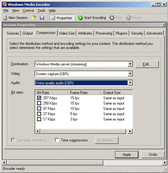Spontaneous screen videos
I can't post the Outlook/SpamBayes video mentioned in this week's column because it reveals too much information about other people. So instead I've posted some experimental videos of LibraryLookup in action:
 I captured these videos with Windows Media Encoder 9, using the settings shown in this screenshot. Each is a bit over 2.5MB, runs about 3 minutes, is stored on a plain Web server, and plays with minimal delay in Windows Media Player 9 on my DSL-connected system.
I captured these videos with Windows Media Encoder 9, using the settings shown in this screenshot. Each is a bit over 2.5MB, runs about 3 minutes, is stored on a plain Web server, and plays with minimal delay in Windows Media Player 9 on my DSL-connected system.
From the perspective of a Windows-based producer creating a software video for Windows-based consumers, things could hardly be easier. After recording the videos I dropped them into my Radio UserLand upload folder and, minutes later, they were available for progressively-downloadable viewing. The key characteristics of this solution:
I'm well aware that there are many potential producers and consumers who are not Windows-based. Indeed, I'm often among those groups myself. Dealing with that problem sacrifices free, or easy, or both. There are free media converters, but it's not easy to acquire them, use them, and deliver multiple formats in a sane way. There are commercial solutions that make things easy -- by targeting Flash, for example, to avoid the WinMedia/Real/QuickTime fireswamp -- but of course they're not free. I mentioned Qarbon, about which several correspondents have said nice things. I've also been referred to Camtasia Studio, and I'm sure there are others. At some point I'd like to experiment with one or more of these professional tools, but for now, let's stay focused on free and easy.
There's a well-understood need for professional screen video tools. Less obvious is the need for non-professional tools. As is painfully clear from the videos I've made, I'm no Xeni Jardin when it comes to narrating technology. But that's exactly the point. Sure, I'd like to improve my voice skills, and if I were creating a training video I'd have to do just that, or hire a voice talent. But imagine, instead, that I'm simply a user of the software, and that I want to show (and tell) other users how it works.
Software users could help one another, and the industry, if they could narrate their experiences with software, and publish those videos as easily as they can now publish blogs. A huge amount of the knowledge that's transferred about software use takes place among users, in the medium of text -- on forums and now also on blogs. Think how much more effective that knowledge transfer would be if users could capture and upload screen videos.
Of course this would make life uncomfortable for software developers who don't want to think about the annoyances that drive users crazy. For example, my wife recently switched from Eudora to Outlook Express. She wanted to Bcc: a message, but couldn't find the button. The reason is that Outlook Express (like Outlook, as a matter of fact) hides it. To get to the place where you can Bcc:, you have to click the To: button. Her response: "How idiotic is that?" And indeed, it's wildly counter-intuitive.
Every application exhibits such annoyances. Developers are blind to them, because they're necessarily focused on making features work. And even experienced users become blind to them, because once you've learned the trick ("click To: or Cc: when you want to Bcc:") the knowledge becomes tacit. To combat this awareness problem, software companies bring in new users, capture their interactions with software on video, and make developers watch the videos. I've been on the receiving end of that treatment; it's painful.
While this focus-group process always improves software, it's expensive. And it doesn't enable users of the shipping product, in the field, to contribute their reactions. Windows Media Encoder, coupled with blog technology, does enable anyone to spontaneously capture and post a screen video that can teach other users about an application, and/or to provide compelling feedback to the developer. I haven't seen this happen yet in blogspace, but I think it can and should. A couple of things (which may or may not already exist) that would help:
One final point for developers: try narrating a video of your own software sometime. It's humbling. When I made these LibraryLookup videos, for example, I was forcibly reminded of all the ways in which LibraryLookup sucks. The canned lists of bookmarklets aren't complete or always accurate. There's no a priori way to know which OPAC your library uses, and therefore which library to search. Nor does the bookmarklet generator adequately solve the problem of identifying your library's OPAC. As I explained the process in the videos, these flaws became painfully apparent because, when we demonstrate and explain, we're forced to experience software from another person's point of view. As a result, I realized that rather than demonstrating workarounds for things like the OPAC-identification issue, I ought to come up with a better solution.
Former URL: http://weblog.infoworld.com/udell/2004/01/16.html#a888
 I captured these videos with Windows Media Encoder 9, using the settings shown in this screenshot. Each is a bit over 2.5MB, runs about 3 minutes, is stored on a plain Web server, and plays with minimal delay in Windows Media Player 9 on my DSL-connected system.
I captured these videos with Windows Media Encoder 9, using the settings shown in this screenshot. Each is a bit over 2.5MB, runs about 3 minutes, is stored on a plain Web server, and plays with minimal delay in Windows Media Player 9 on my DSL-connected system.